Solar Roof Design for Cooling & Heating
VerifiedAdded on 2020/05/11
|6
|1106
|163
AI Summary
This engineering project explores the design of a solar roof system for both heating and cooling residential buildings. It delves into various methods, including roof ponds and radiative cooling, analyzing their effectiveness and costs. The project evaluates a specific design incorporating water distribution within the roof structure and its integration with existing hot-water heating systems. A cost-benefit analysis is presented, considering material, labor, and energy savings.
Contribute Materials
Your contribution can guide someone’s learning journey. Share your
documents today.
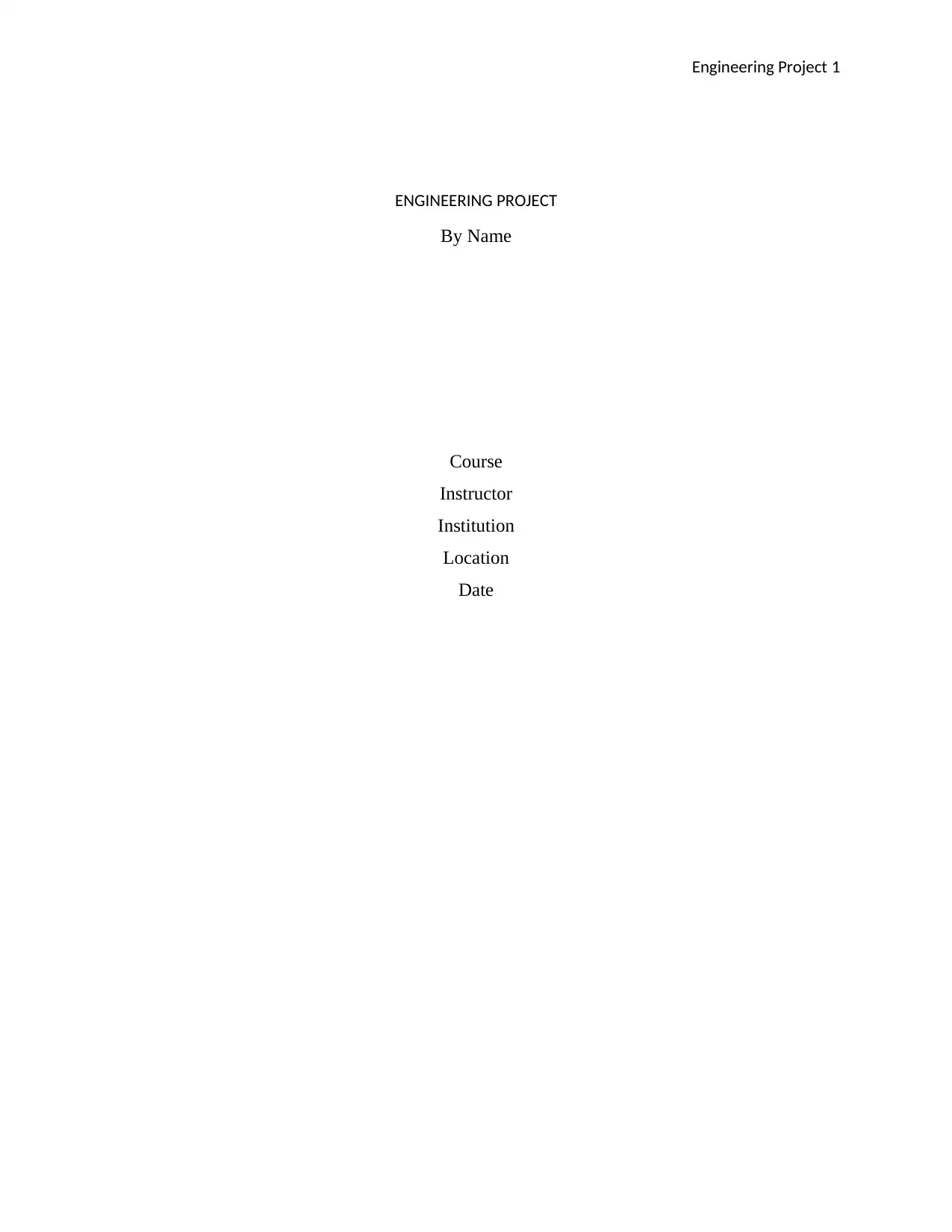
Engineering Project 1
ENGINEERING PROJECT
By Name
Course
Instructor
Institution
Location
Date
ENGINEERING PROJECT
By Name
Course
Instructor
Institution
Location
Date
Secure Best Marks with AI Grader
Need help grading? Try our AI Grader for instant feedback on your assignments.
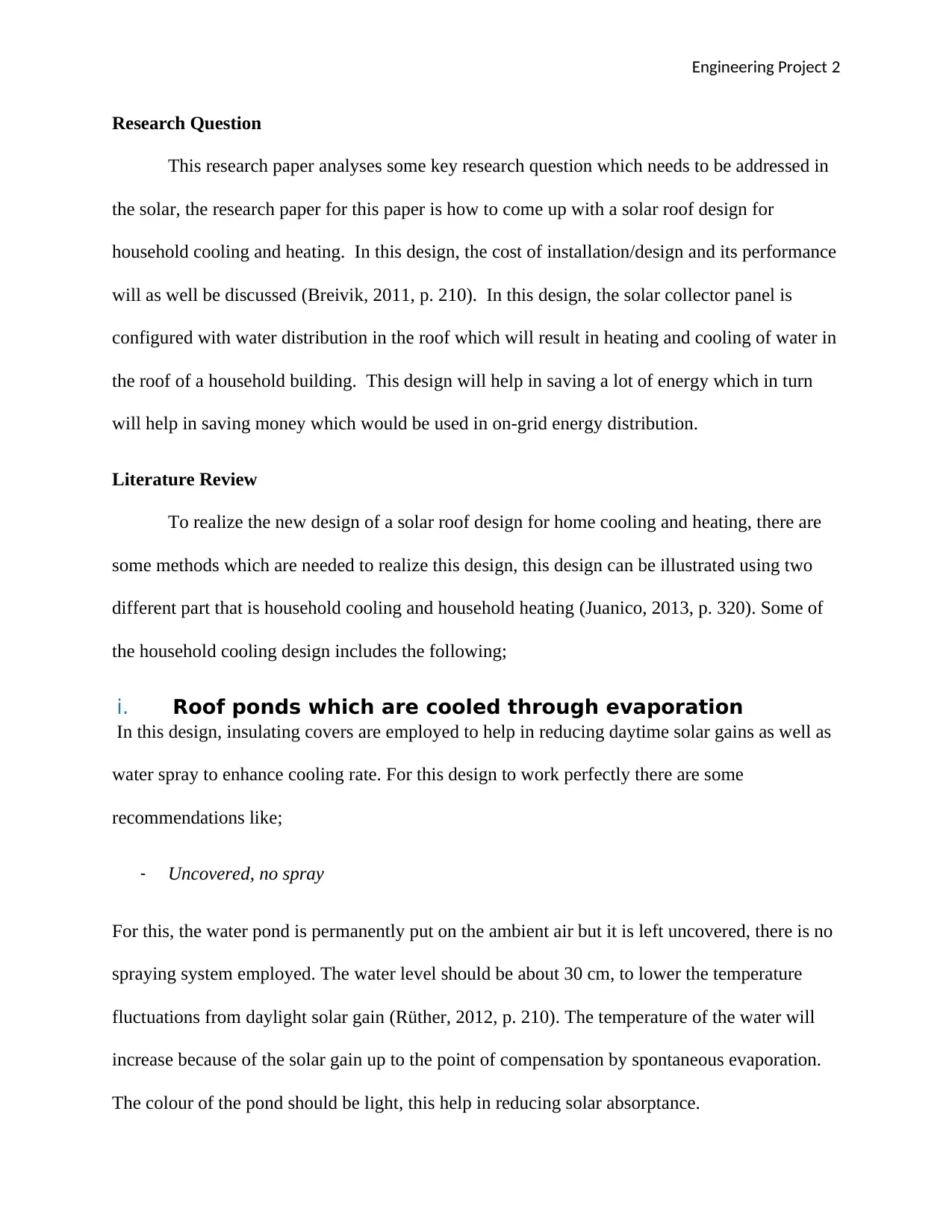
Engineering Project 2
Research Question
This research paper analyses some key research question which needs to be addressed in
the solar, the research paper for this paper is how to come up with a solar roof design for
household cooling and heating. In this design, the cost of installation/design and its performance
will as well be discussed (Breivik, 2011, p. 210). In this design, the solar collector panel is
configured with water distribution in the roof which will result in heating and cooling of water in
the roof of a household building. This design will help in saving a lot of energy which in turn
will help in saving money which would be used in on-grid energy distribution.
Literature Review
To realize the new design of a solar roof design for home cooling and heating, there are
some methods which are needed to realize this design, this design can be illustrated using two
different part that is household cooling and household heating (Juanico, 2013, p. 320). Some of
the household cooling design includes the following;
i. Roof ponds which are cooled through evaporation
In this design, insulating covers are employed to help in reducing daytime solar gains as well as
water spray to enhance cooling rate. For this design to work perfectly there are some
recommendations like;
- Uncovered, no spray
For this, the water pond is permanently put on the ambient air but it is left uncovered, there is no
spraying system employed. The water level should be about 30 cm, to lower the temperature
fluctuations from daylight solar gain (Rüther, 2012, p. 210). The temperature of the water will
increase because of the solar gain up to the point of compensation by spontaneous evaporation.
The colour of the pond should be light, this help in reducing solar absorptance.
Research Question
This research paper analyses some key research question which needs to be addressed in
the solar, the research paper for this paper is how to come up with a solar roof design for
household cooling and heating. In this design, the cost of installation/design and its performance
will as well be discussed (Breivik, 2011, p. 210). In this design, the solar collector panel is
configured with water distribution in the roof which will result in heating and cooling of water in
the roof of a household building. This design will help in saving a lot of energy which in turn
will help in saving money which would be used in on-grid energy distribution.
Literature Review
To realize the new design of a solar roof design for home cooling and heating, there are
some methods which are needed to realize this design, this design can be illustrated using two
different part that is household cooling and household heating (Juanico, 2013, p. 320). Some of
the household cooling design includes the following;
i. Roof ponds which are cooled through evaporation
In this design, insulating covers are employed to help in reducing daytime solar gains as well as
water spray to enhance cooling rate. For this design to work perfectly there are some
recommendations like;
- Uncovered, no spray
For this, the water pond is permanently put on the ambient air but it is left uncovered, there is no
spraying system employed. The water level should be about 30 cm, to lower the temperature
fluctuations from daylight solar gain (Rüther, 2012, p. 210). The temperature of the water will
increase because of the solar gain up to the point of compensation by spontaneous evaporation.
The colour of the pond should be light, this help in reducing solar absorptance.
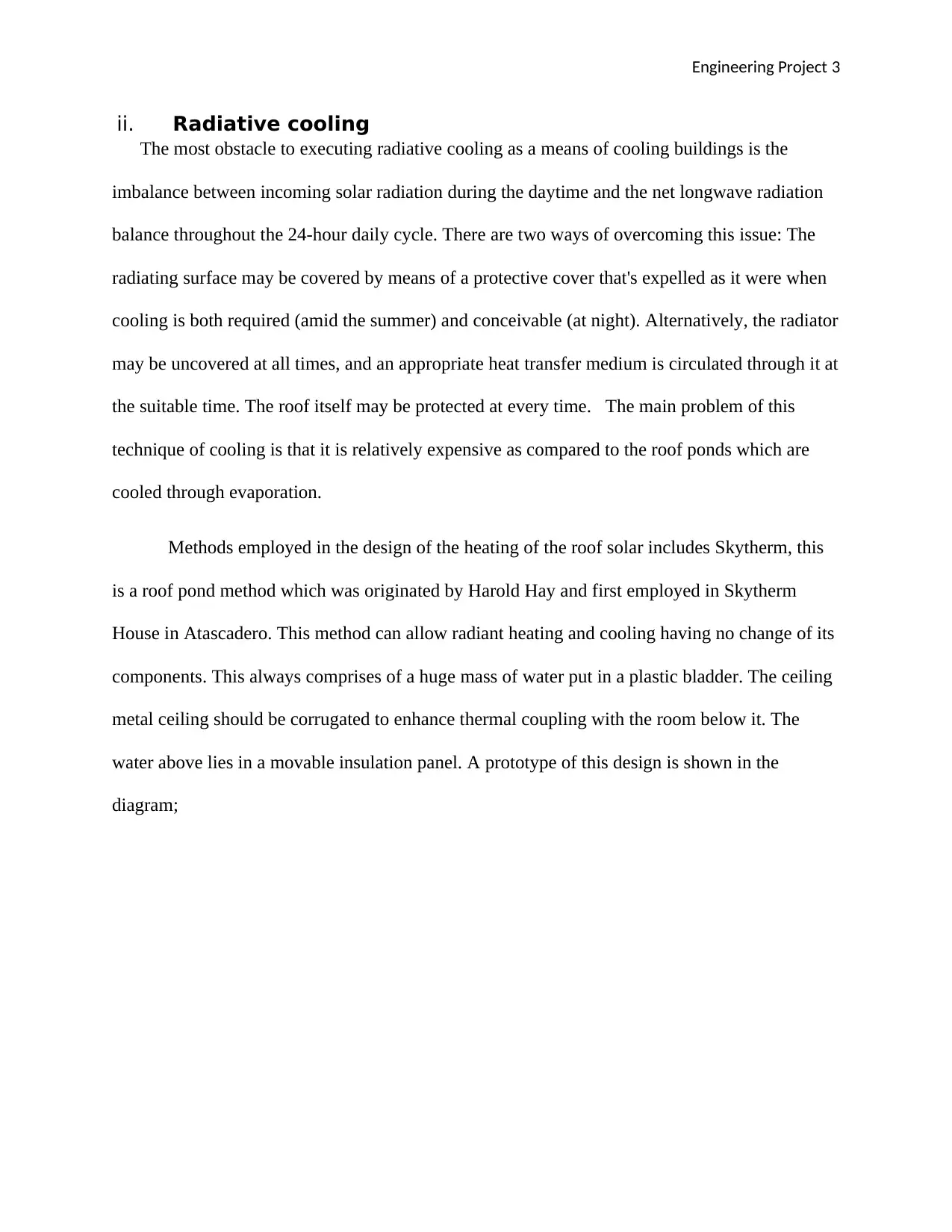
Engineering Project 3
ii. Radiative cooling
The most obstacle to executing radiative cooling as a means of cooling buildings is the
imbalance between incoming solar radiation during the daytime and the net longwave radiation
balance throughout the 24-hour daily cycle. There are two ways of overcoming this issue: The
radiating surface may be covered by means of a protective cover that's expelled as it were when
cooling is both required (amid the summer) and conceivable (at night). Alternatively, the radiator
may be uncovered at all times, and an appropriate heat transfer medium is circulated through it at
the suitable time. The roof itself may be protected at every time. The main problem of this
technique of cooling is that it is relatively expensive as compared to the roof ponds which are
cooled through evaporation.
Methods employed in the design of the heating of the roof solar includes Skytherm, this
is a roof pond method which was originated by Harold Hay and first employed in Skytherm
House in Atascadero. This method can allow radiant heating and cooling having no change of its
components. This always comprises of a huge mass of water put in a plastic bladder. The ceiling
metal ceiling should be corrugated to enhance thermal coupling with the room below it. The
water above lies in a movable insulation panel. A prototype of this design is shown in the
diagram;
ii. Radiative cooling
The most obstacle to executing radiative cooling as a means of cooling buildings is the
imbalance between incoming solar radiation during the daytime and the net longwave radiation
balance throughout the 24-hour daily cycle. There are two ways of overcoming this issue: The
radiating surface may be covered by means of a protective cover that's expelled as it were when
cooling is both required (amid the summer) and conceivable (at night). Alternatively, the radiator
may be uncovered at all times, and an appropriate heat transfer medium is circulated through it at
the suitable time. The roof itself may be protected at every time. The main problem of this
technique of cooling is that it is relatively expensive as compared to the roof ponds which are
cooled through evaporation.
Methods employed in the design of the heating of the roof solar includes Skytherm, this
is a roof pond method which was originated by Harold Hay and first employed in Skytherm
House in Atascadero. This method can allow radiant heating and cooling having no change of its
components. This always comprises of a huge mass of water put in a plastic bladder. The ceiling
metal ceiling should be corrugated to enhance thermal coupling with the room below it. The
water above lies in a movable insulation panel. A prototype of this design is shown in the
diagram;
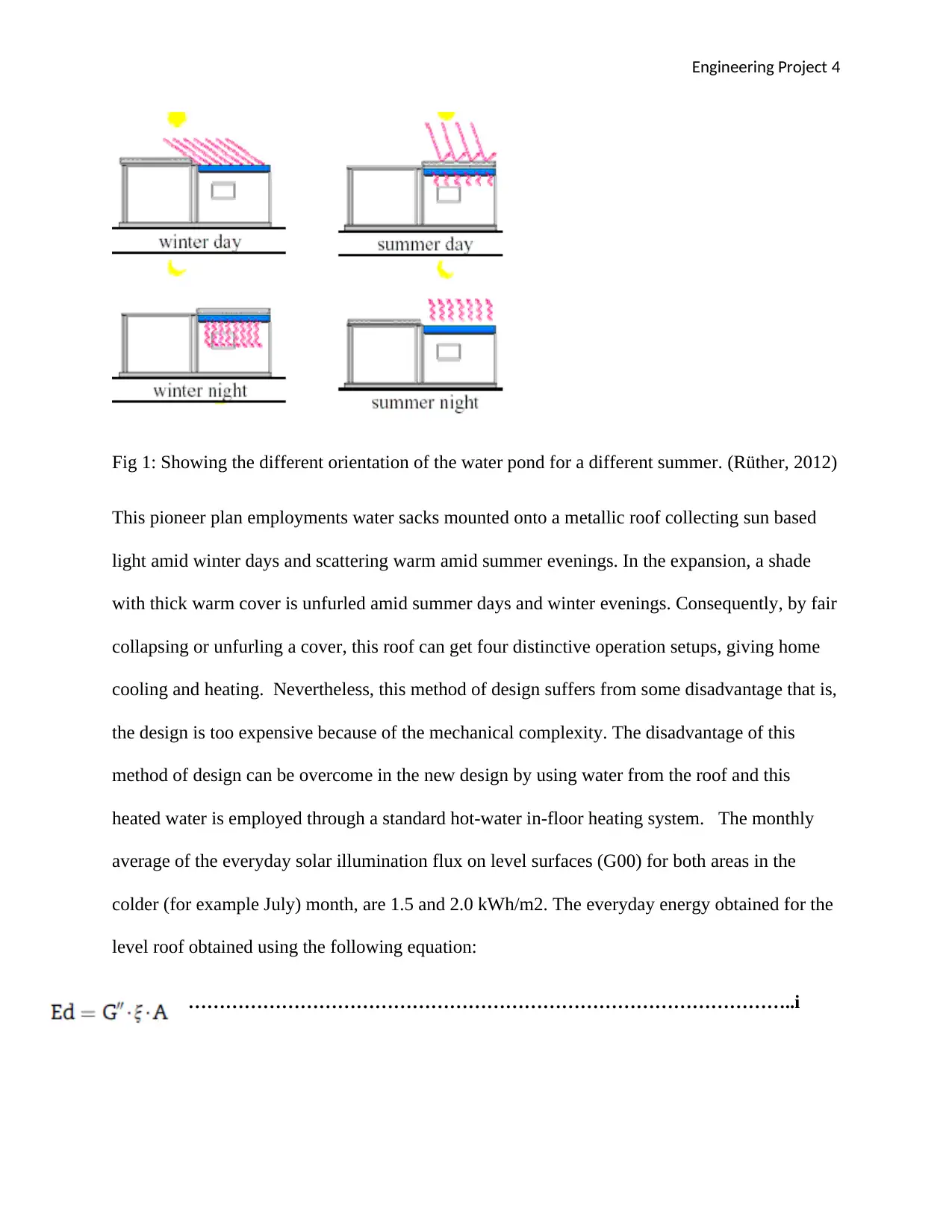
Engineering Project 4
Fig 1: Showing the different orientation of the water pond for a different summer. (Rüther, 2012)
This pioneer plan employments water sacks mounted onto a metallic roof collecting sun based
light amid winter days and scattering warm amid summer evenings. In the expansion, a shade
with thick warm cover is unfurled amid summer days and winter evenings. Consequently, by fair
collapsing or unfurling a cover, this roof can get four distinctive operation setups, giving home
cooling and heating. Nevertheless, this method of design suffers from some disadvantage that is,
the design is too expensive because of the mechanical complexity. The disadvantage of this
method of design can be overcome in the new design by using water from the roof and this
heated water is employed through a standard hot-water in-floor heating system. The monthly
average of the everyday solar illumination flux on level surfaces (G00) for both areas in the
colder (for example July) month, are 1.5 and 2.0 kWh/m2. The everyday energy obtained for the
level roof obtained using the following equation:
……………………………………………………………………………………..i
Fig 1: Showing the different orientation of the water pond for a different summer. (Rüther, 2012)
This pioneer plan employments water sacks mounted onto a metallic roof collecting sun based
light amid winter days and scattering warm amid summer evenings. In the expansion, a shade
with thick warm cover is unfurled amid summer days and winter evenings. Consequently, by fair
collapsing or unfurling a cover, this roof can get four distinctive operation setups, giving home
cooling and heating. Nevertheless, this method of design suffers from some disadvantage that is,
the design is too expensive because of the mechanical complexity. The disadvantage of this
method of design can be overcome in the new design by using water from the roof and this
heated water is employed through a standard hot-water in-floor heating system. The monthly
average of the everyday solar illumination flux on level surfaces (G00) for both areas in the
colder (for example July) month, are 1.5 and 2.0 kWh/m2. The everyday energy obtained for the
level roof obtained using the following equation:
……………………………………………………………………………………..i
Secure Best Marks with AI Grader
Need help grading? Try our AI Grader for instant feedback on your assignments.
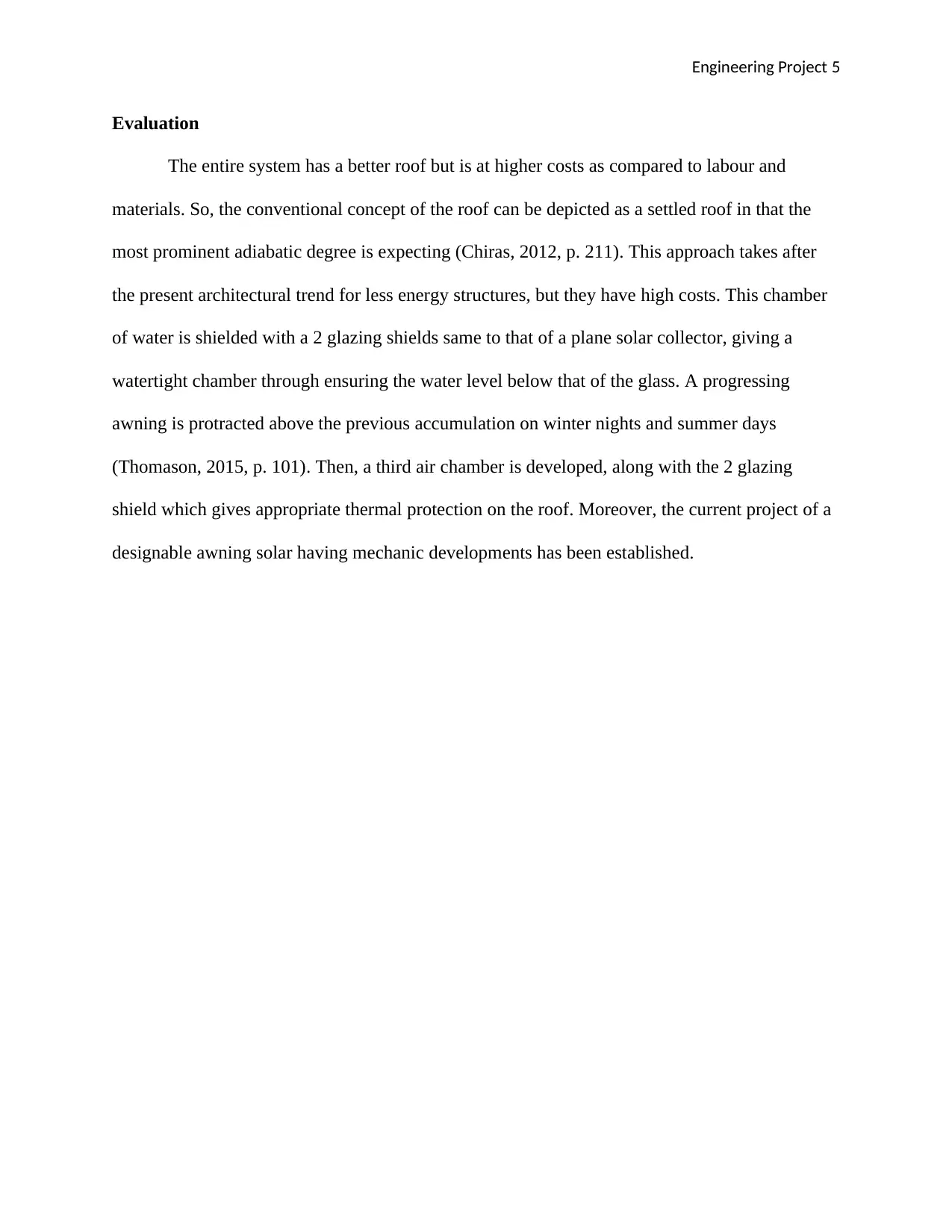
Engineering Project 5
Evaluation
The entire system has a better roof but is at higher costs as compared to labour and
materials. So, the conventional concept of the roof can be depicted as a settled roof in that the
most prominent adiabatic degree is expecting (Chiras, 2012, p. 211). This approach takes after
the present architectural trend for less energy structures, but they have high costs. This chamber
of water is shielded with a 2 glazing shields same to that of a plane solar collector, giving a
watertight chamber through ensuring the water level below that of the glass. A progressing
awning is protracted above the previous accumulation on winter nights and summer days
(Thomason, 2015, p. 101). Then, a third air chamber is developed, along with the 2 glazing
shield which gives appropriate thermal protection on the roof. Moreover, the current project of a
designable awning solar having mechanic developments has been established.
Evaluation
The entire system has a better roof but is at higher costs as compared to labour and
materials. So, the conventional concept of the roof can be depicted as a settled roof in that the
most prominent adiabatic degree is expecting (Chiras, 2012, p. 211). This approach takes after
the present architectural trend for less energy structures, but they have high costs. This chamber
of water is shielded with a 2 glazing shields same to that of a plane solar collector, giving a
watertight chamber through ensuring the water level below that of the glass. A progressing
awning is protracted above the previous accumulation on winter nights and summer days
(Thomason, 2015, p. 101). Then, a third air chamber is developed, along with the 2 glazing
shield which gives appropriate thermal protection on the roof. Moreover, the current project of a
designable awning solar having mechanic developments has been established.
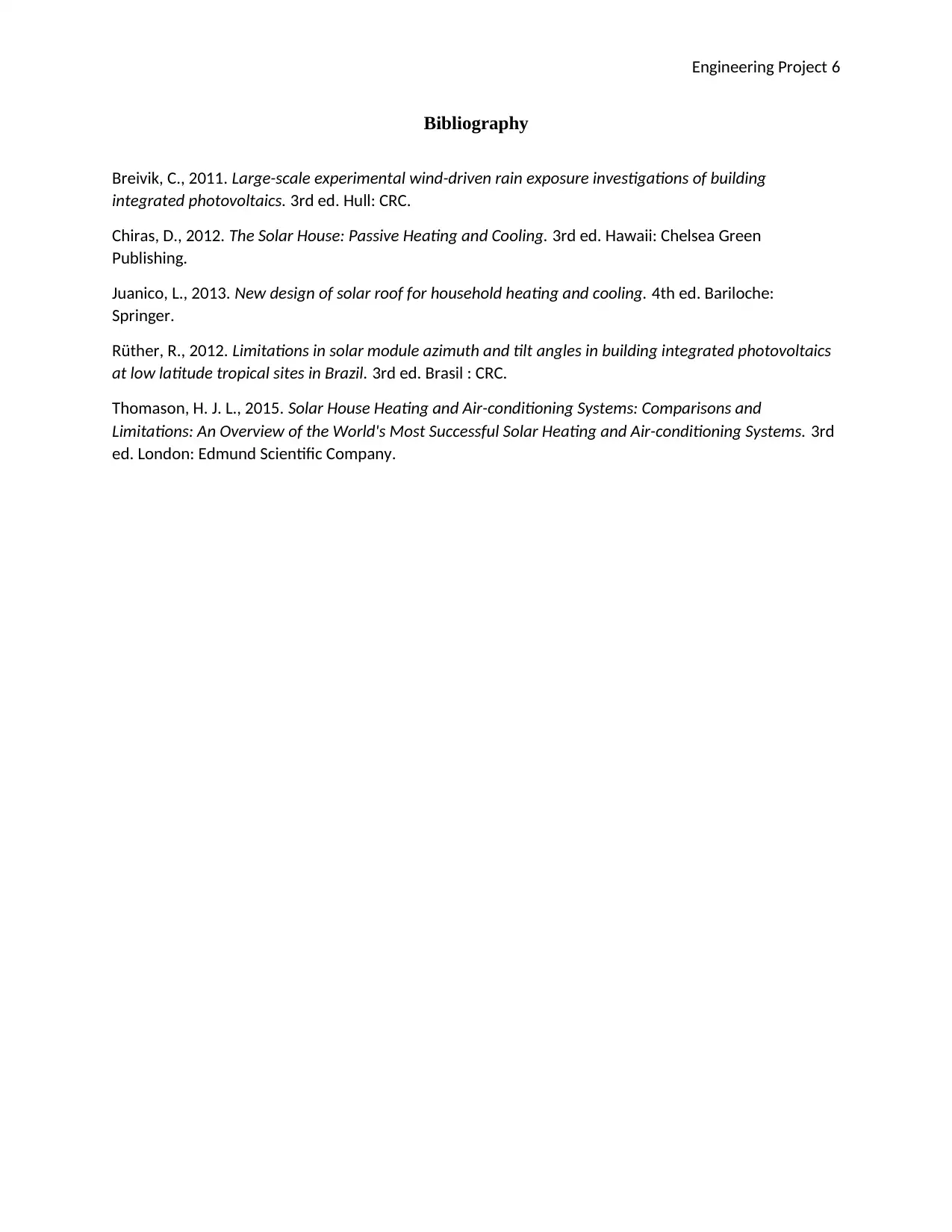
Engineering Project 6
Bibliography
Breivik, C., 2011. Large-scale experimental wind-driven rain exposure investigations of building
integrated photovoltaics. 3rd ed. Hull: CRC.
Chiras, D., 2012. The Solar House: Passive Heating and Cooling. 3rd ed. Hawaii: Chelsea Green
Publishing.
Juanico, L., 2013. New design of solar roof for household heating and cooling. 4th ed. Bariloche:
Springer.
Rüther, R., 2012. Limitations in solar module azimuth and tilt angles in building integrated photovoltaics
at low latitude tropical sites in Brazil. 3rd ed. Brasil : CRC.
Thomason, H. J. L., 2015. Solar House Heating and Air-conditioning Systems: Comparisons and
Limitations: An Overview of the World's Most Successful Solar Heating and Air-conditioning Systems. 3rd
ed. London: Edmund Scientific Company.
Bibliography
Breivik, C., 2011. Large-scale experimental wind-driven rain exposure investigations of building
integrated photovoltaics. 3rd ed. Hull: CRC.
Chiras, D., 2012. The Solar House: Passive Heating and Cooling. 3rd ed. Hawaii: Chelsea Green
Publishing.
Juanico, L., 2013. New design of solar roof for household heating and cooling. 4th ed. Bariloche:
Springer.
Rüther, R., 2012. Limitations in solar module azimuth and tilt angles in building integrated photovoltaics
at low latitude tropical sites in Brazil. 3rd ed. Brasil : CRC.
Thomason, H. J. L., 2015. Solar House Heating and Air-conditioning Systems: Comparisons and
Limitations: An Overview of the World's Most Successful Solar Heating and Air-conditioning Systems. 3rd
ed. London: Edmund Scientific Company.
1 out of 6
Your All-in-One AI-Powered Toolkit for Academic Success.
+13062052269
info@desklib.com
Available 24*7 on WhatsApp / Email
![[object Object]](/_next/static/media/star-bottom.7253800d.svg)
Unlock your academic potential
© 2024 | Zucol Services PVT LTD | All rights reserved.



